Self-builders in Hjärtum’s parsonage village 2026. A popular movement that raises the sparsely populated countryside
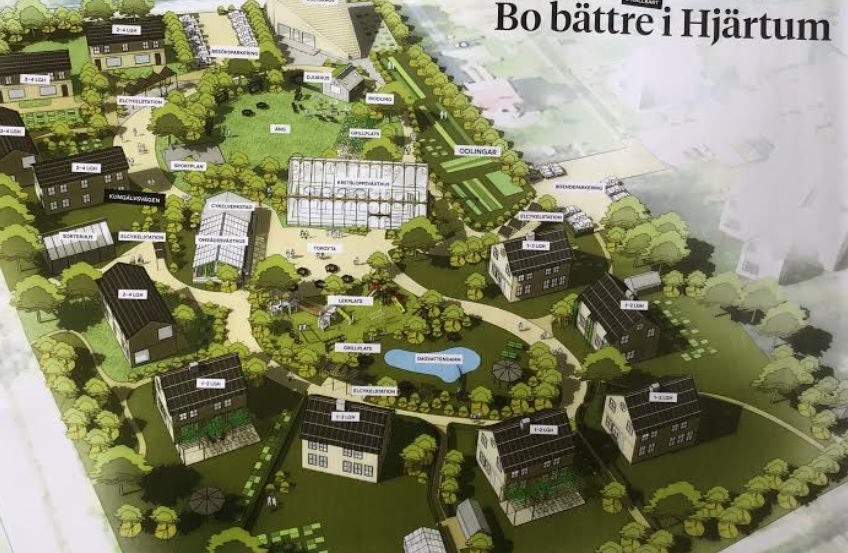

The fall 2019 exhibition was like giving birth to a baby. What will the kid do? Quite benign it turns out. During the conception, the people of the countryside got a wish list for what an eco-village should be. Something that architect Erik Berg then visualized in a bunch of sketches.

Everything did not fall on the lip. A chicken house in the middle of the village with a rooster mad in the wee hours? Carpentry workshop, with cutting blades that sound worse than the tip? So few houses in the village and so many communal facilities, how expensive will it be? Most doubted the municipal officials, burned by previous attempts.
The economic reality made the project’s fire-spirits, Mai Lundell and Mikaela Hult, think in new paths. The working group summarized experiences from a number of study visits. One was the Eco Village in Röstånga . Another: the ladies with collective living in Gerlesborg . A third went to the Egnahems factory at Tjörn .
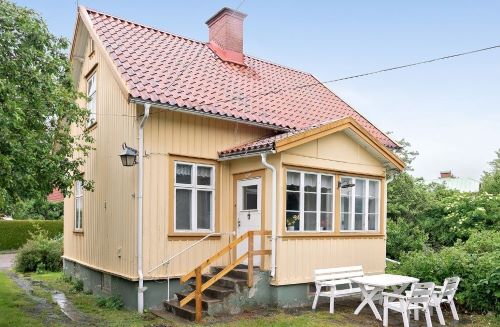
The Pollette fell when Mai and Mikaela in the fall of 2020 drove the Trollhättan wrong and ended up in the idyll Hjulkvarn . There they saw small houses with apple trees in glittering gardens, some on paved streets. In common people called Egnahem, for they were built in the early nineteenth century thanks to the private home movement . Similar to the houses where I live in Hjärtum’s church village, Mikaela noted. Or, as the real estate agent’s advertising stated in May:
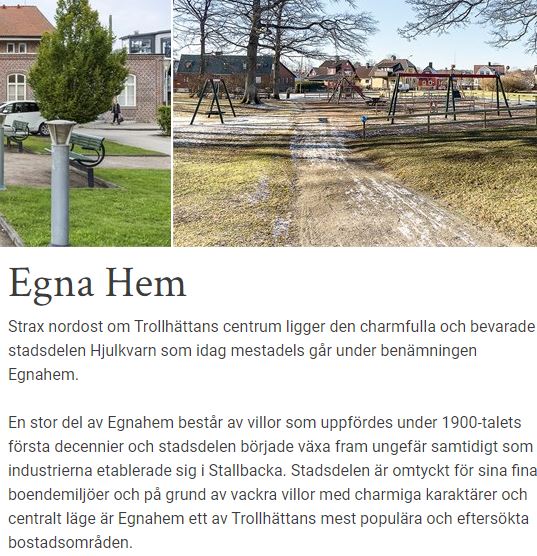
Own hardened gold host
The Egna home movement was a popular movement that took off at the turn of the last century , first for smallholders so that they did not have to become statesmen or had to emigrate. A cow and a potato field kept the famine away.
Moving into the city’s unhealthy rental barracks brought with it congestion and social problems. Workers and officials were therefore offered good conditions for building a small house with a pitch for fruits and vegetables. The bourgeois authorities saw their own homes as a countermeasure to the socialists who were starving and threatened with revolution.
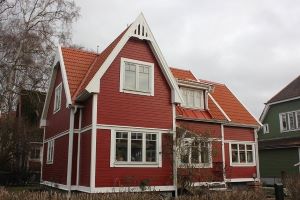 Enskede’s garden city is such a suburban environment with well-preserved Enskede villas. For the financing, rental of the upper level contributed with a kitchen. Often, permanent jobs and orderly finances were required, counter book. Must be sober and unpunished.
Enskede’s garden city is such a suburban environment with well-preserved Enskede villas. For the financing, rental of the upper level contributed with a kitchen. Often, permanent jobs and orderly finances were required, counter book. Must be sober and unpunished.
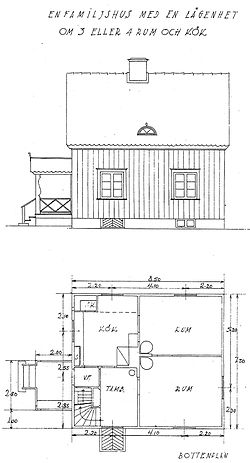 The movement lifted in the 1920s for private homes fit into the Social Democrats’ ideal of home. Borrow government loans to 90% and then set aside the cash contribution with your own work. Often 64 sqm with three rooms and kitchen and basement below.
The movement lifted in the 1920s for private homes fit into the Social Democrats’ ideal of home. Borrow government loans to 90% and then set aside the cash contribution with your own work. Often 64 sqm with three rooms and kitchen and basement below.
The maximum ceiling of 6,000 in annual salary made the district red, populated by workers and lower officials. However, after the war, the home equity programs. With a screaming housing shortage in the 1960s, self-construction was replaced by large-scale industrial construction in insanely called concrete suburbs.
Self-construction in Stockholm gained momentum in 1927 when the city’s Småstugebyrå bought land in areas such as Enskede and Bromma. Support for the buildings was provided with drawings and advice. Craftsmen erected the frame and fixed installations. The rest managed the self-builders. In the 1930s, a typical private home could cost SEK 500 in effort and 10,000 in loans. In the seventies, prices were a little over SEK 100,000. Today, the average price for a house in Gamla Enskede is upwards of 10 million. The idyll is a receipt of how people want to live.
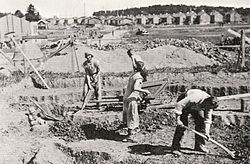
Much is the same today. Housing shortage because young people cannot afford if they even get loans at the bank. Ideally, one escapes from suburban problems to something calmer. The eco-trend with own cultivation is spreading.
The ground is important in Hjärtum
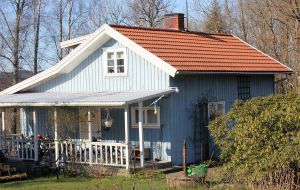
Why reinvent the wheel was reasoned in autumn 2020 in the project Bo Sustainable in Hjärtum . We plan the house-house movement and build in the same still as the other hundred-year-old houses in the church village.
Although more durable and energy efficient. ”We form an economic home association and a home company like you did in the early nineteenth century” . Voluntary forces are at their core, but paid project managers are also needed.
“Not just a holiday village in Hjärtum for now, it is about becoming a people’s movement for the new era’s home business. With many committed who with a lot of money working long term ” . This is how Mai and Mikaela reasoned in 2021 and started “The Egnahems movement in Hjärtum oak. association ”and for the qualified project work Småstugorna i Hjärtum AB.
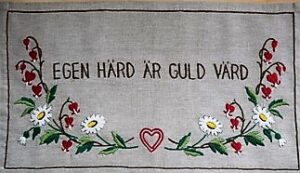
The campaign got the Economic Association to divide the members into responsibilities: initially policy lobbying, land issues, financing, market strategy and media.
And the resource inventory group not least; where are available premises, available land and useful skills in the countryside? The association’s new thinkers had to work hard in a village that ended up in municipal backwater. At its most, a new house per year according to the old master plan : “Some urban development is suitable for strengthening the town’s service base. The population is relatively stable and no major change is expected in the foreseeable future ” .
In the preliminary business plan that the village’s new thinkers sent to the municipal office, a parliamentary motion for 2018 included “A new home business” from the center parties Larsson and Åkesson, attached
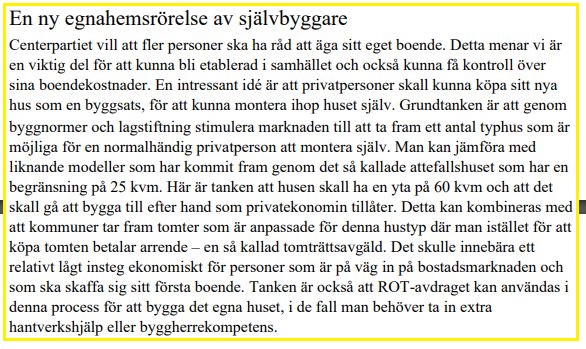
Julia Färjhage (c) from Västerlanda, snapped directly. For she is the chairman of the local council and wants to put Hjärtum on the map with something unique. The parsonage park was perfect for the municipality. Because with stricter compliance with the environmental code you can no longer build on the fields around Lilla Edet and Lödöse.
Rye in the back in the fight against the municipal bureaucrats got the association with a reference group with heavy names in politics, popular movements and business. A experienced project manager with social pathos, Johan Larsson, was recruited to collaborate with architect Erik Berg in Småstugorna i Hjärtum AB. Listen to the pod with Berg.
Coffers?
EU money as a Leader project for the Gäta River Valley is good start-up aid , but they do not go far if you want to achieve the EU goals of growth and increased employment. Hardest to get many new taxpayers as relief on a crisis economy in the municipality of Lilla Edet.
Government grants, online fundraising, sponsors, investors? The association’s financial team had several bites to fund. The project was broken down into parts to fit the coffers.
In 2018, the Stockholm company, the Office for Own Homes, received SEK 300,000 from Vinnova for the project A new home business.
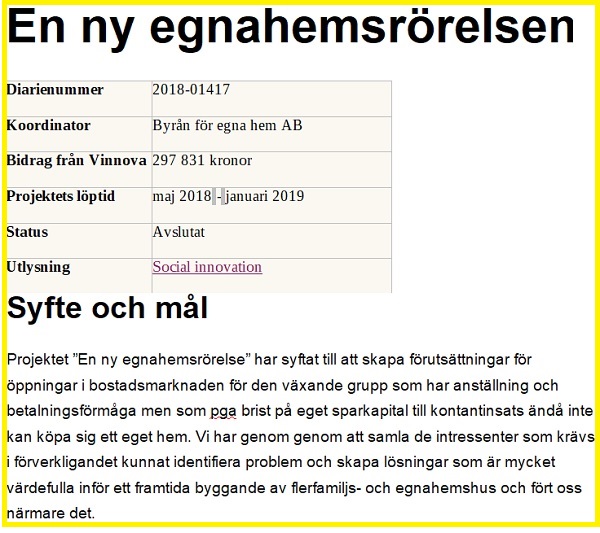
After reading Vinnova’s project program , the authority granted the Cardiac Society’s request of SEK 3 million for the social housing test bench – in collaboration with academic institutions.
The ribs were raised and the cash register was then filled for a five-year plan with money from the EU, Region Götaland and several others. The base plate has ten million beds for the construction project in the church village. But also to develop the self-concept of self-construction and reach target groups in Sweden and internationally.
The market?
 40% of young people leaving the study want to live in a villa. 31% prefer tenancy and tenancy right 17%. It noted the Youth Barometer in one of the reports studied by the Heart Society’s strategy group in detail. Admittedly, Lilla Edet is one of the few municipalities in the Gothenburg region where, according to Dagens nyheter’s Housing Guide , young people can afford to obtain a condominium.
40% of young people leaving the study want to live in a villa. 31% prefer tenancy and tenancy right 17%. It noted the Youth Barometer in one of the reports studied by the Heart Society’s strategy group in detail. Admittedly, Lilla Edet is one of the few municipalities in the Gothenburg region where, according to Dagens nyheter’s Housing Guide , young people can afford to obtain a condominium.
Almost 80,000 young people aged 20-27 in the Stockholm region were forced to stay at home. Although nine out of ten wanted to live differently. This was shown by the Tenants Association’s mapping in 2019 .
It was just as badly done in the Gothenburg region. Galloping house prices cause the city to scrap large-scale planes , such as until 2035 for SEK 1,000 billion to build 80,000 homes for 150,000 new Gothenburg residents. With an outdated infrastructure that causes the city to die from traffic jams. The alternative is to expand further into the region with one or another hour’s travel to the city. Assuming that many with telework can commute every other day or not commute at all ..
In Lilla Edet, apartments are no longer being built and good land is being sought. Not expensive though (often SEK 300-500) but not very attractive. Not even the region of West Götaland believes in the municipality of Lilla Edet. The population of just over 14,000 was only expected to increase by one and a half thousand by 2030 . Most in the southern part of the sparse countryside northwards disappears.
Equally bad in the wreath municipalities. If you do not succeed in entering the housing career, the market goes into reverse. The elderly do not sell the villa because there is no alternative to move to. It became the cultivation of the Cardiac Society’s marketing strategy. Investing in young and old for without schools, the church village is not a good choice for families with children.
So we want to stay
The Swedish Property Agency’s trending trend in 2018 among 2,500 Swedes showed that three out of ten dreamed of a house in the countryside, preferably in a villa with a lake plot. Many also in a red cabin with white knots. The same percentage for the longing for the countryside was reported in Västra Götaland. (But slightly less for big cities like Stockholm and Gothenburg, 14 and 19%). What is considered most important is having 200 meters close to nature and green space. As many as 53% think so. 57% want to live where they live in twenty years – but 18% think they have moved to a red cottage in the country.
From the report : “Although many people move into the big cities every year, that is not what the Swedes really dream about. On the contrary, the villa with lake plot is at the top of the wish list. After that, living in a medium-sized town and in the archipelago most people dream about. Only eighth mean that their dream home is in a big city. ”
This knowledge was sufficient for the strategy group to break down the young into segments, attractive as taxpayers in the municipality. On social media, the association focused on young eco-interested people in neighboring cities, in some cases unsafe in the suburbs.
Commitments for nature, dogs and horses were gates when the association’s market volunteers worked on Facebook, sometimes also with paid advertisements. Another target group was young entrepreneurs who could just as well work in the parish or commute to most a couple of days a week. Therefore, the student environments were given the highest priority.
35 surveying students at the University College West worked 11,000 hours over 10 weeks to plan the district of New Hjulkvarn Trollhättan in detail. Based on surveys and budgets, a park town by the river was sketched with housing and offices. With such a successful result that prospective surveyors in 2021 conducted a similar case study for Hjärtum’s church village.
What does the exploitation cost so that young people can afford it? Best mix of nature and yet close to the big city pulse? Best place for a startup? Such questions got students at the University of the West and Chalmers to answer. Two flies in one fell swoop, for Hjärtumföreningen got a contact area for more collaborations with the universities.
The bishop’s blessing
In 2019, Lilla Edet, the country’s ninth most indebted municipality, went back 24 million. The ax in the care got more people to seek help from the church. Raise church tax? A couple that earns 600,000 a year must pay out in Hjärtum with 6,000 church taxes. If you do not leave the congregation, say, which more and more do. Just over 2,000 of the parish’s more than 3,000 were members of the congregation in 2018. Half of the decrease was due to exits requested. Although property needed to be sold for the sake of the economy, it was equally important to increase the number of members. Moving into the church village could be one way.
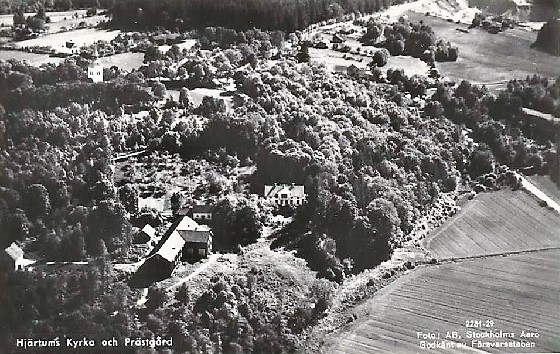
What got the diocese to sell the parsonage land to the eco village’s economic association in 2020 was the architect’s vision. He wants out of the overgrown deciduous forest to create a park between the church and the parsonage, overlooking the river valley. And in the park provide space for sustainable living for young and old.
Google view from Kärrsbackevägen between the church and the parsonage:
A number of plots provided the congregation with plots to lower the threshold for young people with some money. A fixed price tag guarantees that the latter can redeem the land. Anyone who engages in the church’s diakonia receives a discount on the plot fee. A winwin, stay cheap in your own house and the congregation gets engaged members.

The result is a garden town in the same style as the old houses in the church village. Community houses are not needed because it is close to the village courtyard, the community center and the sports ground. Other things are arranged afterwards, like redoing the old school.
factory
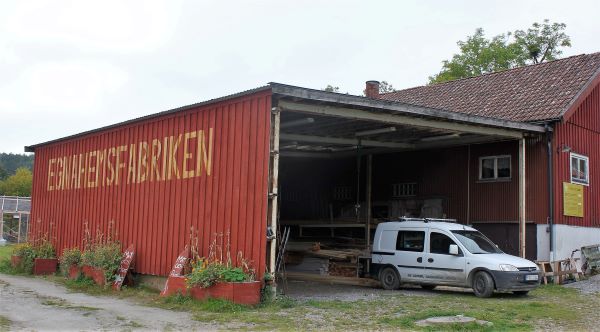
The working group visited the Egnahems factory at Tjörn, where architect Erik Berg is a driving force. There, house elements are built by young and old, many of whom are newly arrived. Thanks to reuse and own work, the construction costs half compared to the directory houses. Counselors make sure everything is properly nailed. You help and maybe make friends for life. In a way, new-age porpoises for houses of max.
The cardiac association did not plan the Egnahems factory straight off. The concept was not expanded unlike the private home operations Småstugebyrå in Stockholm almost a hundred years earlier. And more than that for the countryside became like a university to dissolve knots in the housing market.
Agneta Svenungson has been a driving force in the project Sustainable Hjärtum from the beginning, in the same way that she started activities in Hjärtumgården. At the family’s Klockarelunden Brattby below the church village, there was an empty barn that suited itself well. This is where the self-employed factory started in the spring of 2022.

The town’s older craftsmen are supervisors. The 60 square plus house is built according to the tradition of the village. Consistent with the major purchase of material on reuse from demolitions is not possible. If the family grows, the attic is decorated or the model is expanded. Klockarlund’s diggers arrange the infrastructure. Machines that can then be rented by the builders to build a garden. See Google view with family company Carpe Ventum at Klockaregården.
Hjärtums Högskola
The factory is full speed evenings and weekends but otherwise there was spare capacity. Thanks to media attention, Småhus i Hjärtum AB started self-build courses; with the practice in the barn and the theory in the old school. Participants are attracted to free house-building courses on the Internet produced by filmmaker Mikaela Hult. Particularly popular is the construction care course how to timber houses like you used to do with cardiac smith Skog’s axes .
So successful that from 2023 training for traditional peasant food is also arranged. The program is inspired by Lotten Lagerstedt who in Hjärtum became a Swedish pioneer for cooking in the countryside. The business took off when TV4 from the kitchen in Klockarelunden broadcast the program Matmammorna with the village’s own food agency Birgitta Rasmusson as program manager. It was the Egnahems movement in Hjärtum oak. association got Arla and LRF as heavy sponsors.
First, the course participants are attracted with egg cheese and soup on gray peas. As bread, they are stimulated to move in with self-construction in Hjärtumbyn.
Home Guard
Look in the DN archive with the word home movement that the popular movement grew in the 1920s. The politicians woke up and with better loans the residential suburbs exploded, where you could get the bus from the train station. Media was important in capturing the interest of resident youth. This experience shaped the strategy for the media group at the Egnahems movement in Hjärtum ek.
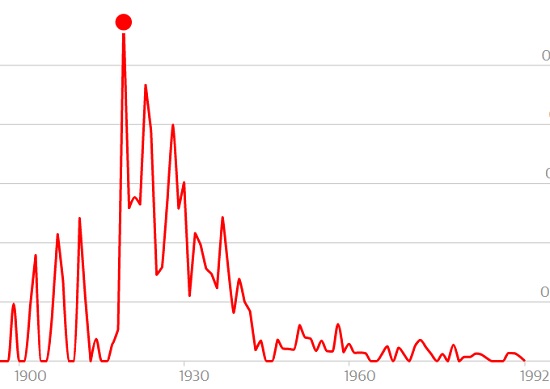
There was no shortage of media-trained people in Hjärum, but the media strategy only took place when the local home defense manager was included in the media group. First artillery with bomb mats in major media. Then in the countryside mobilize the ”home defense” in a kind of shooting company attacking social media. Selective against the groups you want to reach in terms of residence and self-construction. With culture and local tourism in the flanks to reach the out-of-town. The longing for the countryside is then strengthened with meetings in Hjärtumgården. The ammunition is loaded by Mikaela Hult, Pernilla Fredholm and others in the area with talent for the media.

Home Guard 2.0 was recruited from the rural associations. People from Hjärtum’s sports association have nested in the neighboring cities’ Facebook groups in sports; wide to cover hikes, role-plays and e-sports in Instagram. Sofia Westergren in Ucklum got online the horse-crazy on the track and other dog lovers were dessert in the same way.
The business association was helped by young IT nerds to attract young entrepreneurs. Not only with nature, but also with a heavy economy. “Sell the condominium in Gothenburg, build cheaply here and you have three million more to start with”.
The church takes on its young parents who want to give the children a good upbringing. In association with the veteran car club, which on Facebook believes in an eternal life for Americans.
The most successful in the rural infantry are the pensioners in the Red Cross and the local community association. Because they have email addresses for grandchildren. With stories, they create a dreamy magic for the neighborhood.
2026
The new houses are among the deciduous trees in the parsonage park. Partly because they are built triple trolls, step by step as you can afford. First bailouts for newlyweds, then larger semi-equipped and finally fully bookable 70 square for young couples.
To quote architect Erik Berg in a newspaper interview : ”We talk about getting an eco-village under one roof, taking a lot of the thinking that eco-villages have worked with for decades, and where the drainage has been a central component,” he says.
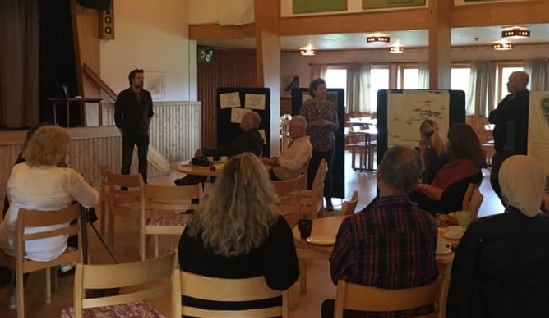
The houses are sparse, for the sake of chimney smoke and to give way to cultivation. Some of the houses in the village separate urine, pox and gray water for purification so that the water fertilizes the cultivation in the greenhouse that surrounds half the house. The purified water is so drinkable that it is reused. Complemented by the rain from the gutter, tap water rarely needs to be taken from the municipal grid.
The wide sides of the houses face south to get the most out of solar panels and glass facades. In a couple of houses, Chalmers researchers are experimenting with the waste in a biogas generator. In others, they try smart technology for compact living, though spacious if needed. A number of projects are underway for Smart village , funded by Vinnova and the EU.
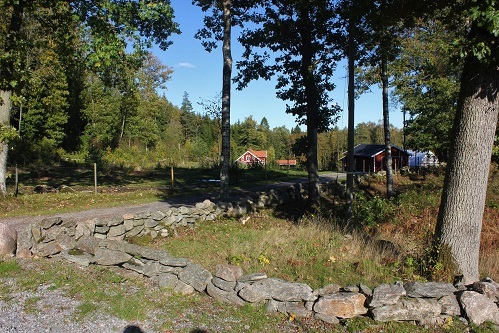
Because they helped each other with the buildings, the cohesion is strong. The only common plant is the benches in the forest slope, where the kids play Indians and build huts. The common is still on the knot: the village courtyard, the Billegården with the parish home, the old school and the sports ground. Not to forget the ancient orphanage, which was made a tourist attraction to Carl Gustaf Swingel’s memory .
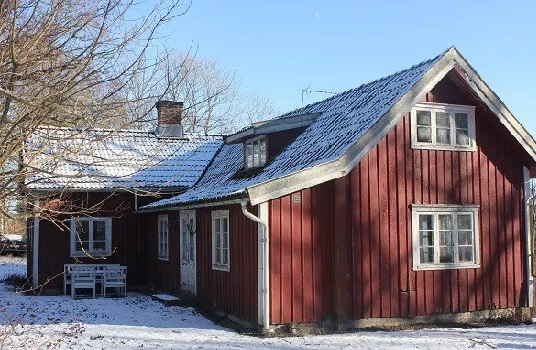
But when the families grow in the eco-village, the cottage becomes too crowded. The housing career often leads to villas and small farms in the area. The problem is that the elderly do not want to sell because the tax eats up almost every fourth of the profit. Instead, many people choose a housing rocket so that they rent houses from each other. The young family as tenants of a larger house and the pensioners vice versa in the rectory park’s house. Everything arranged with a swap website Småstugorna under the auspices of Hjärtum AB. If Queen Silvia is in the notes, the idea is that the elderly living in the village should be organized as a run by a SiviaBo.
/ By Ingemar Lindmark
